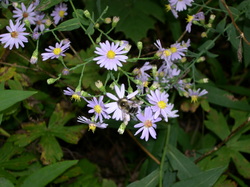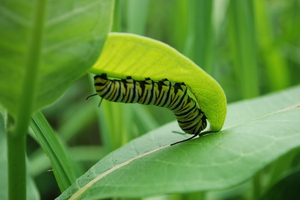Native plants and the critters that love them

Bee enjoying a snack on a Smooth Aster (Aster laevis).
Rick Meader|Contributor
Plants are great, but native plants are significantly greater in terms of supporting insects and the birds that feed on them. That is the point driven home in a very entertaining and informative book called "Bringing Nature Home" by Douglas W. Tallamy. I’ve enjoyed native plants for their beauty, interest and historical basis, but until I read this book, I never understood their significance as a basis for the survival of birds, as well as insects.

Monarch butterfly caterpillar hides under and feeds on a Common Milkweed (Asclepias syriaca).
Rick Meader|Contributor
As an entomologist at the University of Delaware, Tallamy has studied the impact of insects on native and non-native plants and found that native plants support, by far, more insects, and, in turn, birds than introduced species. He takes the next logical step by contending that if we don’t increase the number and quantity of native plants in our own personal landscapes, then the populations of insects, and therefore birds, will drop with the continuing reduction and fragmentation of natural landscapes seen with growing human populations.
This book is not a landscaping book, and is not always a light read. Be prepared for a lot of scientific names of plants, insects and birds. But don’t be afraid! You’ll learn a lot, and not just scientific stuff. He also brings in human interest points, like the location of the nursery where mile-a-minute weeds started their spread across Pennsylvania and other points in the United States. He gives personal accounts of his experiences with native plants, deerflies and his neighbor Sam, and his writing style is definitely more accessible than you’d find in a scientific journal.
To me, the most useful sections of the book were his analyses of why native plants are more desirable to native insects than non-natives (yes, insects and birds can also be native to a region), why plants can’t just “become native” if they’ve been around awhile and which plant genera are most useful, in terms of supporting animal life (not just insects). You’ve probably never heard any of this information before (I know I hadn’t), and it is absolutely crucial information to have if you’re interested in preserving the plants and animals of our area from extinction.
But, no less enjoyable and informative were his outstanding photographs of plants and insects, the descriptions of various insect families that birds eat, the stories he shares about his own landscape, and the question-and-answer section at the end of book where he poses and answers commonly asked questions about native plants. This is particularly useful for talking with folks who aren’t on the native plant bandwagon, or who may be, but don’t know some of the interesting information backing up the wisdom of using native plants.
He also has included a comprehensive table as an appendix, where he lists the host plants of butterflies and moths (all native to the United States). As he is based on the East Coast, not all of the plants occur naturally in Michigan, but many do, so I am including it as a downloadable PDF in this blog, with the permission of Professor Tallamy.
bringing nature home appendix 2.pdf
If you want to buy this book for yourself, and I hope you will, you can get it at the Matthaei Botanical Gardens bookstore or other bookstores, as well as through his Bringing Nature Home Web site.
Get one for a friend or family member, too, or at least share your copy when you’re done with it, and enjoy the read.
Enjoy nature, everyone!
Rick is a local landscape architect with a special interest in all things natural, including native plants and the critters that eat them. You can contact him at yourland1824@gmail.com.


Comments
Epengar
Wed, Mar 17, 2010 : 2:05 p.m.
Rick, can you edit past posts? you might want to add some of the links here to your first story, and then make a habit of linking to that page from your future stories. It would be nice if all these resources were in one place, and that other AA.com content pointed to them.
AlphaAlpha
Tue, Mar 16, 2010 : 9:33 p.m.
Outstanding. Thank you, everyone. I will certainly investigate these links. Seems like not too long ago it was common for at least some of the landscaping to be edible. Not so much now. High time to fix that...
Rick Meader
Tue, Mar 16, 2010 : 8:37 p.m.
Thanks for all of your comments, everyone, and suggestions of other information sources and activities, Epengar. Regarding edible native plants, you might want to read Linda Feldt's blog on AnnArbor.com Food and Drink section called Wildcrafting (http://www.annarbor.com/entertainment/food-drink/wildcrafting-and-linda-diane-feldt/). She talks about all kinds of edible things she finds in nature. Thanks again for all of your interest, and input, everyone. Rick
Epengar
Tue, Mar 16, 2010 : 7:54 p.m.
I just discovered that Rick posted many of the same links (plus more!) in his previous post to AnnArbor.com: http://www.annarbor.com/home-garden/native-plants---sources-of-information-to-grow-your-knowledge/ Here's a couple more: The local cluster of the Stewardship Network (a Michigan networking group for groups and people interested in land conservation) is sponsoring a two-hour presentation on native gardening next Monday evening here in town: http://www.stewardshipnetwork.org/site/c.hrLOKWPILuF/b.5161347/k.682A/The_Huron_Arbor_Cluster.htm Also, we have an active chapter of Wild Ones, a national organization dedicated to promoting environmentally sound landscape practices, they're very big on native plants, and have garden tours and other events throughout the year: http://www.for-wild.org/chapters/annarbor/
Dante Marcos
Tue, Mar 16, 2010 : 6:59 p.m.
For native edibles, you've got to check out Michigan's own Oikos Tree Crops: http://www.oikostreecrops.com/store/home.asp?cookiecheck=yes&
Epengar
Tue, Mar 16, 2010 : 5:09 p.m.
We certainly do have some edible natives, but I don't know of a good online source (I've never seriously looked though). Eating raises the stakes, I would want a good reference. This might be good: Weatherbee, Ellen Elliott and James Bruce. Edible Wild Plants of the Great Lakes Region. University of Michigan, 1979. Looks like it's out of print though. I'm pretty sure Ms Weatherbee teaches classes at the UM Botanic Gardens, so maybe they'd be a good place to ask. http://www.lsa.umich.edu/mbg/ It wouldn't surprise me if they teach an edible plants class once in a while.
AlphaAlpha
Tue, Mar 16, 2010 : 4:50 p.m.
Very helpful comment with sources, Epengar. Edible native plants. Any ideas? Thanks.
Epengar
Tue, Mar 16, 2010 : 3:27 p.m.
MSU Extension has a great website about planting native plants to promote beneficial insects, both pollinators like bumblebees and butterflies, and also the parasitic (non-stinging) wasps that are vital for control of pest insects. The site gives suggestions for which plants to plant, what they look like, and what conditions they need: http://nativeplants.msu.edu/ The city's Natural Area Preservation unit has a great set of brochures listing and describing native local species that are suitable for landscaping and gardens. You can download them, or get printed copies for cheap. http://www.a2gov.org/government/publicservices/fieldoperations/NAP/NativePlants/Pages/NativePlants.aspx The County Conservation District also promotes the use of native plants, and has an annual tree and native plant sale, happening right now. http://www.washtenawcd.org/ There are several nurseries in the region that specialize in native plants. Nearest is The Native Plant Nursery LLC, in Ann Arbor. They sell their plants at the Farmer's Market, and their website has great photos http://www.nativeplant.com/ There is a state-wide association for native plant nurseries, their website lists nurseries across the state http://www.mnppa.org/
Rork Kuick
Tue, Mar 16, 2010 : 1:20 p.m.
That pdf parses poorly on my machine, but folks could print it I suppose, or open two copies next to each other. I think I could fight it into better formats but it'd be work. Still, a heroic effort to not merely review the book, but bring the data home with permission! Thanks to Tallamy too. PS: It would be nice if these posts were easier for folks to stumble into. We have various experts around here that might have juicy details in future, but they have to be able to find this first.